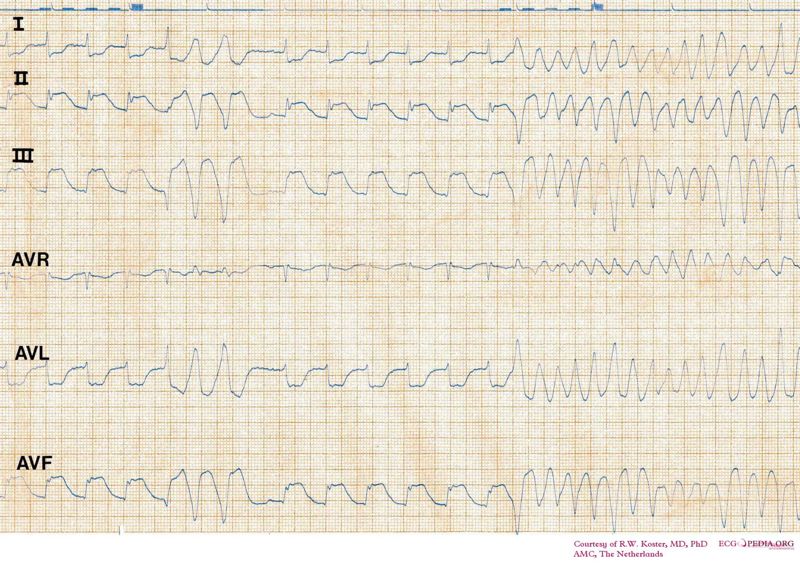Ventricular fibrillation EKG examples
Editor-In-Chief: C. Michael Gibson, M.S., M.D. [1]
For the main page on Ventricular fibrillation, click here
EKG examples
The EKG below shows irregular heart rhythm, heart rate of more than 300 per minute, QRS duration unrecognizable and absent P waves depicting ventricular fibrillation.

Copyleft image obtained courtesy of Wikipedia, http://en.wikipedia.org/wiki/File:Lead_II_rhythm_generated_ventricular_fibrilation_VF.JPG
The EKG below shows irregular heart rhythm, heart rate of more than 300 per minute, QRS duration unrecognizable and absent P waves depicting ventricular fibrillation .

Copyleft image obtained courtesy of ECGpedia, http://en.ecgpedia.org/wiki/File:Rhythm_ventricular_fibrillation.png
The EKG below shows sinus rhythm converting into ventricular fibrillation wave pattern of irregular rhythm and unrecognizable QRS and P waves in all the leads depicting ventricular fibrillation.

Copyleft image obtained courtesy of ECGpedia, http://en.ecgpedia.org/wiki/File:ECG_SR_to_VF_in_INF_MI.jpg
The EKG below shows three panels which are continuous and represent the testing of a Medronic model 7219 defibrillator. The channels are a surface EKG lead, a ventricular intra-cardiac recording and a marker channel from the device.
The first panel shows rapid paced ventricular beats followed by a low energy shock which induces ventricular fibrillation. The shock is not on the T wave.

Copyleft image obtained courtesy of ECGpedia, http://en.ecgpedia.org/wiki/File:E00031731.jpg
The second EKG of the panel below shows no identifiable QRS complexes and P waves, bizarre waveform depicting ventricular fibrillation. Note the readings of the marker channel.

Copyleft image obtained courtesy of ECGpedia, http://en.ecgpedia.org/wiki/File:E00031732.jpg
The last EKG of the panel below shows the termination of the ventricular fibrillation with a 20 joule shock and then ventricular pacing. Note the ST elevation of the paced beats.

Copyleft image obtained courtesy of ECGpedia, http://en.ecgpedia.org/wiki/File:E00031733.jpg
The EKG monitor strip below shows induction of ventricular fibrillation with paced beats and a low energy T wave shock, termination of the ventricular fibrillation by the device and then the return to sinus rhythm. The tracing was made during the implantation of the defibrillator in a middle aged woman with ventricular tachycardia and a structurally normal heart. The recording was done during the testing of the defibrillator . Note the QT interval in this patient of 500 ms which is long for the heart rate of 60/min.

Copyleft image obtained courtesy of ECGpedia, http://en.ecgpedia.org/wiki/File:E00031733.jpg